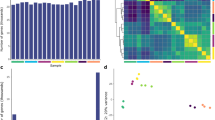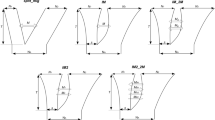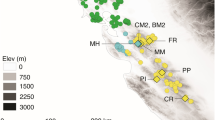Abstract
Electrophoresis was used to examine levels of association between alleles at different variable loci within eight natural populations of the annual plant, Impatiens capensis. This species produces both obligately self-fertilizing cleistogamous (CL) and strongly protandrous chasmogamous (CH) flowers. Values of gametic (Dij) and composite (Δij) disequilibrium estimated for all pairs of covarying loci revealed significant levels of disequilibrium in most of the populations. A bootstrap technique was used to obtain weighted means and standard errors of normalized disequilibrium estimates and these were compared among populations and groups. Mean composite disequilibrium (Δ′) spanned a remarkable range among populations (0·9−1·0, mean = 0·43), as did fixation indexes (f), but these were only weakly correlated with each other (r = 0·50). Levels of disequilibrium in the CL and CH progeny generally resembled those found in their maternal parents, but values for the CH group were more variable. A reduction in disequilibrium was sometimes associated with outcrossing, but it is unlikely that selection to reduce disequilibrium favours outcrossing in this species.
Similar content being viewed by others
Article PDF
References
Allard, R W, Babbel, G R, Clegg, M T, and Kahler, A L. 1972a. Evidence for coadaptation in Avena barbata. Proc Natl Acad Sci (USA), 69, 3043–3048.
Allard, R W, Kahler, A L, and Weir, B S. 1972b. The effect of selection on esterase allozymes in a barley population. Genetics, 72, 489–503.
Baker, W K. 1975. Linkage disequilibrium over space and time in natural populations of Drosophila montana. Proc Natl Acad Sci USA, 72, 4095–4099.
Black, W C, and Krafsur, E S. 1985. A FORTRAN program for the calculation and analysis of two-locus linkage disequilibrium coefficients. Theor Appl Genet, 70, 491–496.
Brown, A, Nevo, E, and Zohary, D. 1977. Association of alleles at esterase loci in wild barley Hordeum spontaneum. Nature, 268, 430–431.
Clegg, M T, Allard, R W, and Kahler, A L. 1972. Is the gene the unit of selection? Evidence from two experimental plant populations. Proc Natl Acad Sci USA, 69, 2474–78.
Cockerham, C C, and Weir, B S. 1968. Sib mating with two linked loci. Genetics, 60, 629–640.
Cockerham, C C, and Weir, B S. 1977. Digenic descent measures for finite populations. Genet Res (Cambridge), 30, 121–147.
Crow, J F. 1988. The importance of recombination. In Michod, R. E. and Levin, B. R. (eds) The Evolution of Sex: An Examination of Current Ideas, Sinauer Associates, Inc., Sunderland, MA, pp. 56–73.
Crow, J F, and Kimura, M. 1970. An Introduction to Population Genetics Theory. Burgess Publ. Co., Minneapolis.
Efron, B. 1982. The Jackknife, the Bootstrap and Other Resampling Plans. Society for Industrial and Applied Mathematics, Philadelphia.
Falconer, D S. 1981. Introduction to Quantiative Genetics (2nd ed.). Longman, New York.
Felsenstein, J. 1974. The evolutionary advantage of recombination. Genetics, 78, 737–756.
Felsenstein, J, and Yokoyama, S. 1976. The evolutionary advantage of recombination. II. Individual selection for recombination. Genetics, 83, 845–859.
Foltz, D W, Schaitkin, B M, and Selander, R K. 1982. Gametic disequilibrium in the self-fertilizing slug Deroceras laeve. Evolution, 36, 80–85.
Guries, R P, and Ledig, F T. 1982. Genetic diversity and population structure in pitch pine (Pinus rigida Mill.). Evolution, 36, 387–402.
Harding, J, and Barnes, K. 1977. Genetics of Lupinus. X. Genetic variability, heterozygosity and outcrossing in colonial populations of Lupinus succulentus. Evolution, 31, 247–255.
Hedrick, P W. 1987. Gametic disequilibrium measures: proceed with caution. Genetics, 117, 331–341.
Hedrick, P W, Jain, S, and Holden, L. 1978. Multilocus systems in evolution. Evol Biol, 11, 101–182.
Heller, R, and Maynard Smith, J. 1978. Does Muller's ratchet work with selfing? Genet Res Camb, 32, 289–293.
Hill, W G, and Robertson, A. 1966. The effect of linkage on limits to artificial selection. Genet Res, Camb, 8, 269–294.
Hill, W G. 1974. Estimation of linkage disequilibrium in randomly mating populations. Heredity, 33, 229–239.
Jain, S K. 1976. The evolution of inbreeding in plants. Ann Rev Ecol Syst, 7, 469–495.
Knight, S E, and Waller, D M. 1987. The genetic consequences of outcrossing in the cleistogamous annual, Impatiens capensis. I. Population-genetic structure. Evolution, 41, 969–978.
Langley, C H, Ito, K, and Voelker, R A. 1977. Linkage disequilibrium in natural populations of Drosophila melanogaster. Seasonal variation. Genetics, 86, 447–454.
Laurie-Ahlberg, C C, and Weir, B S. 1979. Allozymic variation and linkage disequilibrium in some laboratory populations of Drosophila melanogaster. Genetics, 92, 1295–1314.
Levin, D A. 1981. Dispersal versus gene flow in plants. Annals Mo Bot Garden, 68, 232–253.
Lewontin, R C. 1964. The interaction of selection and linkage. I. General considerations; heterotic models. Genetics, 49, 49–67.
Lewontin, R C. 1974. The Genetic Basis of Evolutionary Change. Columbia Univ. Press, New York.
Maynard Smith, J. 1978. The Evolution of Sex. Cambridge University Press, Cambridge.
Mitchell-Olds, S T, and Waller, D M. 1985. Relative performance of selfed and outcrossed progeny in Impatiens capensis. Evolution, 39, 533–544.
Nei, M, and Li, W H. 1973. Linkage disequilibrium in subdivided populations. Genetics, 75, 213–219.
Ohta, T. 1982. Linkage disequilibrium with the island model. Genetics, 101, 139–155.
O'Malley, D, Wheeler, N C, and Guries, R P. 1980. A manual for starch gel electrophoresis. Staff Paper, College of Agriculture and Life Sciences, Univ. of Wisconsin, Madison.
Schemske, D S. 1978. Evolution of reproductive characteristics in Impatiens (Balsaminaceae): The significance of cleistogamy and chasmogamy. Ecology, 59, 596–613.
Smouse, P E, and Neel, J V. 1977. Multivariate analysis of gametic disequilibrium in the Yanomama. Genetics, 85, 733–752.
Strobeck, C, Maynard Smith, J, and Charlesworth, B. 1976. The effects of hitchhiking on a gene for recombination. Genetics, 82, 547–588.
Uyenoyama, M. 1988. On the evolution of genetic incompatibility systems: Incompatibility as a mechanism for the regulation of outcrossing distance. In Michod, R. E. and Levin, B. R. (eds) The Evolution of Sex: An Examination of Current Ideas, Sinauer Associates, Inc., Sunderland, MA, pp. 212–232.
Waller, D M. 1979. The relative costs of selfed and outcrossed seeds in Impatiens capensis (Balsaminaceae). Amer J Bot, 66, 313–320.
Waller, D M. 1980. Environmental determinants of outcrossing in Impatiens capensis (Balsaminaceae). Evolution, 34, 147–761.
Waller, D M. 1984. Differences in fitness between seedlings derived from cleistogamous and chasmogamous flowers in Impatiens capensis. Evolution, 38, 427–440.
Waller, D M, and Knight, S. 1989. Genetic consequences of outcrossing in the cleistogamous annual, Impatiens capensis. II. Outcrossing rates and genetic correlations. Evolution (In press).
Weir, B S. 1979. Inferences about linkage disequilibrium. Biometrics, 35, 235–254.
Weir, B S, Allard, R W, and Kahler, A L. 1972. Analysis of complex allozyme polymorphisms in a barley population. Genetics, 72, 505–523.
Weir, B S, and Cockerham, C C. 1973. Mixed self and random mating at two loci. Genet Res, Camb, 21, 247–262.
Weir, B S, and Cockerham, C C. 1979. Estimation of linkage disequilibrium in randomly mating populations. Heredity, 42, 105–111.
Woods, C S. 1975. The Balsaminaceae in the Southeastern United States. J Arnold Arbor, 56, 413–426.
Author information
Authors and Affiliations
Rights and permissions
About this article
Cite this article
Waller, D., Knight, S. Genetic consequences of outcrossing in the cleistogamous annual, Impatiens capensis. III. Interlocus associations. Heredity 63, 1–9 (1989). https://doi.org/10.1038/hdy.1989.69
Received:
Issue date:
DOI: https://doi.org/10.1038/hdy.1989.69
This article is cited by
-
Unexpectedly high levels of selfing in the Australian shrub Grevillea barklyana (Proteaceae)
Heredity (1994)
-
Restricted gene flow within the morphologically complex species Persoonia mollis (Proteaceae): contrasting evidence from the mating system and pollen dispersal
Heredity (1994)
-
Multilocus structure in Pinus contorta Dougl.
Theoretical and Applied Genetics (1993)



